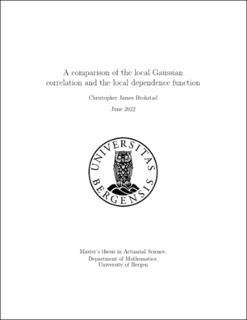A Comparison of the local Gaussian correlation and the local dependence function
Master thesis
Permanent lenke
https://hdl.handle.net/11250/2999669Utgivelsesdato
2022-06-01Metadata
Vis full innførselSamlinger
- Master theses [120]
Sammendrag
Correlation is a method to measure the relation between two or more variables. In this thesis, a method of measuring correlation and a method of measuring dependence are used. These two methods, are the local Gaussian correlation and the local dependence function. The goal was to build a bridge between these two measurements. The hypothesis is that for a bivariate normal density, both methods will locally approximate the densities correlation coefficient. The local dependence function is a measure of dependence and it has to be transformed to give the function of the correlation. However, there was not a clear connection between the two methods. Instead of the local dependence function, the precision matrix was utilised. The precision matrix provides an opportunity to find the correlation coefficient locally for the bivariate normal density. Thus, a bridge between the local Gaussian correlation and the correlation estimate from the precision matrix can be built. To obtain the correlation estimate from the precision matrix, it has to be transformed to its inverse, the covariance matrix. However, while a connection was made, some details remain unclear. This is observed, with the local Gaussian correlation being defined for the range of the density. While the estimated correlation for the precision matrix has areas that are undefined for certain densities. The function of the estimated correlation from the precision matrix is discussed, to explain why some areas are undefined and why the estimate takes the form it does for different densities. The two methods also produced differing correlation estimates for given areas. In this thesis, the same set of test case densities are used, as the ones in the introductory paper for the local dependence function (Jones, 1996), and its preliminary paper (Doksum et al., 1994). As the local Gaussian correlation is an empirical method of measuring correlation, it needs data. For this thesis there is no observed data, therefore instead simulated data are used in the analyses. The correlation estimate from the precision matrix, on the other hand requires the densities to be known. To further explore the precision matrix’s correlation estimate, two novel methods are explored; the Box-Cox transformation and the Gaussian kernel estimates, but they require further work. In conclusion, while a bridge is constructed between the local Gaussian correlation and the precision matrix’s correlation estimate, more work is needed to establish a clearer connection.
